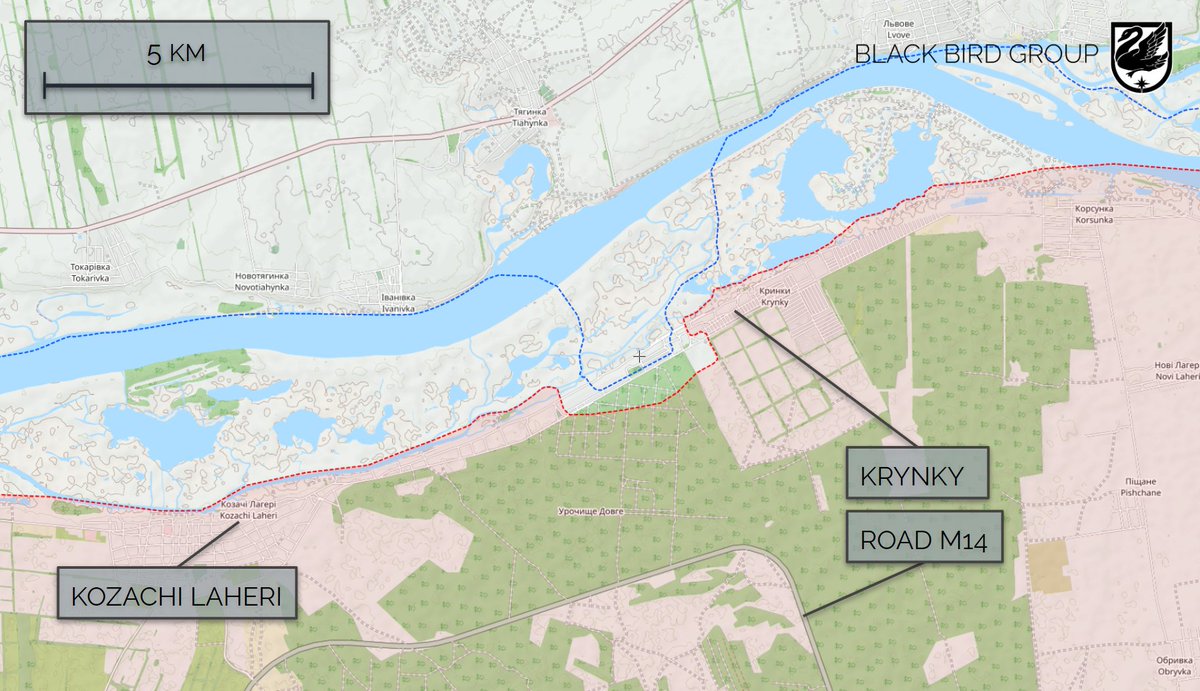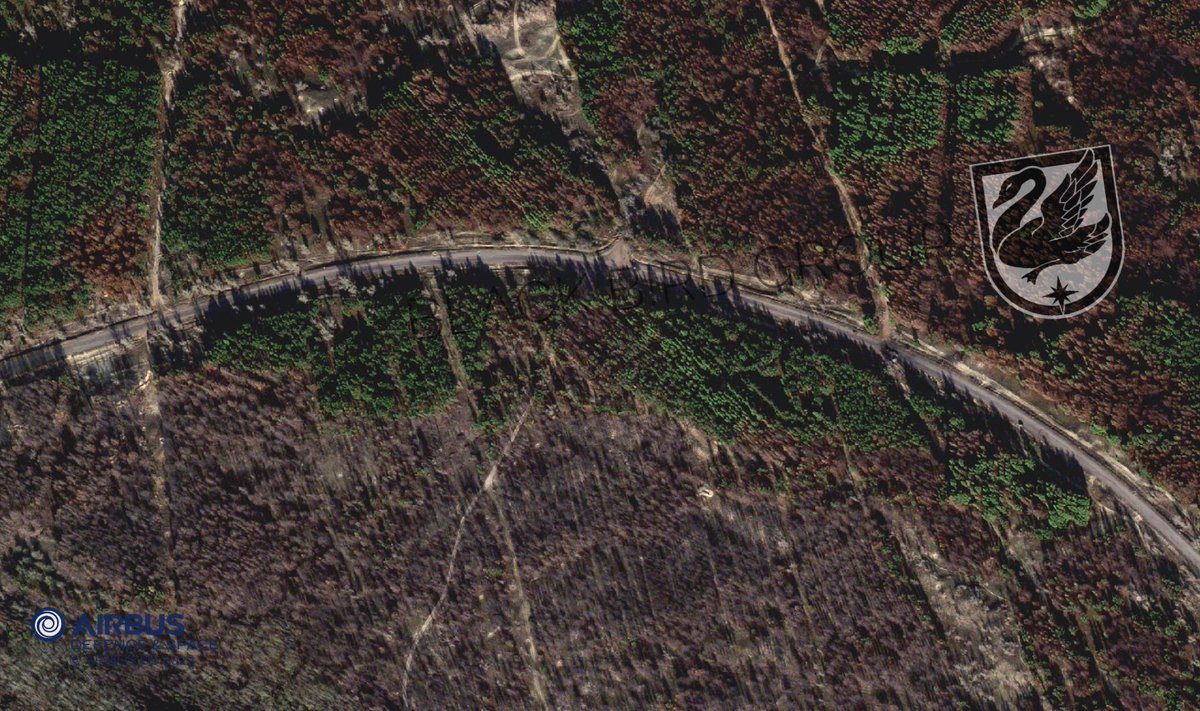Ukrainian operations on the eastern bank of the Dnipro river, in the village of Krynky, have been ongoing since October 2023.
In this thread, I'll analyze the current situation and the future of the bridgehead in Krynky.
The thread includes high-resolution satellite images. 1/
In this thread, I'll analyze the current situation and the future of the bridgehead in Krynky.
The thread includes high-resolution satellite images. 1/

A brief timeline of the events in the Dnipro River Delta since the liberation of Kherson. The “river war” has been a long process, often conducted in challenging conditions.
However, it has not generally been discussed as much in the media as some other sectors. 2/
However, it has not generally been discussed as much in the media as some other sectors. 2/

In the village of Krynky, Ukrainian forces have been fighting a difficult battle for a prolonged time. The area controlled by Ukraine is small and natural cover is very limited. There is a forest next to the village, but it seems the Ukrainians have not advanced far into it. 3/ 

Russians have been using artillery, rocket launcher systems and aerial bombs against the Ukrainian positions in the village. The infrastructure has suffered significant damage and the ground is full of craters. We can see an example of that in this picture. 4/ 

The large aerial bomb craters may act as an indicator of the width of the permanent Ukrainian presence in the village. They are found along a distance of about 2400 metres, mostly near the first row of houses. This also correlates with recent geolocated material from the area. 5/ 

The river banks have also been actively bombed, and the craters quickly fill with water. The main supply route is most likely the Konka river, where Russia, of course, tries to monitor all larger Ukrainian movements and prevent logistics from working. 6/ 

The entire village is not under Ukrainian control. At the moment it seems that Ukraine is largely focused on holding on to what it has achieved, instead of attempting to gain full control. Ukrainian officials have also recognized the difficulties of the operation. 7/ 

Over the course of months, Russia had built fortifications in Krynky in two ranks – right next to the river and closer to the forest. Some of these have been captured by Ukraine. Russia also seems to have dug new positions on the east side of the village during the battle. 8/ 

Russians have launched multiple counterattacks against the bridgehead. Videos suggest that they do not attempt larger, coordinated assaults, but instead repeatedly send small detachments against Ukrainian positions, often from the same directions, with no significant results. 9/
Here we can see a part of the Russian losses. Various vehicles and a tank were destroyed or abandoned over the course of weeks. Advancing along this road has not brought success, but the Russians still seem to think it's a militarily reasonable avenue of approach. 10/ 

Some have mentioned that cutting the road M14 could be one of Ukraine’s goals, as it would complicate Russian logistics. I would see it more as a small setback for the Russians, but they could still supply their troops using other, slightly longer routes. 11/ 

From the satellite images, we can see that Russia is also prepared to defend the area beyond Krynky, including the M14. Even half a kilometre long trench can be seen, among other defensive positions. 12/ 

Ukrainian efforts have been mostly focused on lighter infantry operations. No heavier Ukrainian equipment has been seen in Krynky, as a mechanized offensive would require bridges over the Dnipro river or at least a larger Ukrainian controlled bridgehead. 13/
Bringing mechanized units over the river and supplying them would eventually become a difficult task, as Ukraine would lack air and fire superiority, especially when Russia would decide to shift its focus more decisively to the area due to increased Ukrainian activity. 14/
The end goal of Ukraine is unclear. At the moment they're able to tie certain Russian forces to the area, and they have conducted successful artillery & drone strikes against targets deep in the rear. 🇷🇺 losses here are significantly higher than 🇺🇦. 15/
https://twitter.com/naalsio26/status/1746002984121626886
Still, the fight consumes and ties Ukrainian resources as well. Fighting an attritional battle in a location like Krynky is difficult, and some reports and interviews indicate that even though Ukraine isn't losing a large amount of equipment, it’s continuously losing men. 16/ 

When looking at the exchange ratio, it’s also a good question whether keeping Ukrainians in the ruins of Krynky is absolutely beneficial for Ukraine. Could it still be possible to cause a decent level of damage to the Russians, without the arduous bridgehead? 17/
The objective may also be political – to show that Ukraine is still able to continue offensive operations in significant directions, even if greater goals do not seem to materialize. Without breakthrough attempts in Zaporizhzhia, the future in Krynky does not look bright. 18/
One reason we don't see more significant efforts against the bridgehead may be that the Russians don’t prioritize it very highly. As the current units are able to control the situation with seemingly acceptable losses, they might feel that no larger operations are needed. 19/
I also don't think the Russians have specific master plan to attrit the Ukrainians in the village. The reportedly weak level of Russian coordination and competence against Ukraine’s rather effective defence allow the situation to continue without a quick end in sight. 20/
Our team at @Black_BirdGroup continues to map and analyze the war. Our interactive map can be found here.
Images in this thread are roughly two weeks old, as I don't want to endanger Ukrainian OPSEC in any way. 21/21
scribblemaps.com/maps/view/The-…
Images in this thread are roughly two weeks old, as I don't want to endanger Ukrainian OPSEC in any way. 21/21
scribblemaps.com/maps/view/The-…
Bonus 💫
Some additional images for geolocators! Your work is priceless, and as I'm using geolocations as a part of my analysis, I want to give something back.




Some additional images for geolocators! Your work is priceless, and as I'm using geolocations as a part of my analysis, I want to give something back.




I also want to thank @wihurinrahasto for making threads like these actually possible. External funding is very important in order to continue our work.
• • •
Missing some Tweet in this thread? You can try to
force a refresh










